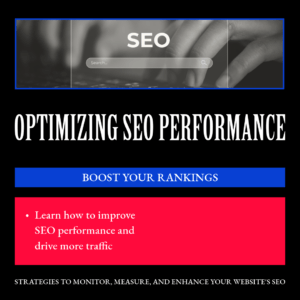Introduction to SEO and Its Importance for Business Websites

Search Engine Optimization (SEO) refers to a collection of strategies and techniques designed to enhance a website’s visibility in search engine results pages (SERPs). For businesses, leveraging SEO is crucial as it directly influences their online presence, organic traffic, and ultimately, their revenue growth.
Businesses exist in competitive environments, and a well-optimized website can mean the difference between being found by potential customers or being buried beneath numerous competitors in search results. In an age where digital interaction is ubiquitous, an effective SEO strategy is essential for driving traffic, building brand credibility, and achieving business goals.
Definition and Basic Principles of SEO
SEO can be defined as the practice of improving the quality and quantity of website traffic from search engines through organic search results. The primary focus of SEO lies not only in attracting visitors but also in ensuring that the right audience visits the page. Here are the basic principles of SEO:
1. Keyword Research: Identifying the terms and phrases that potential customers are using to search for products or services.
2. On-Page Optimization: Enhancing individual web pages to rank higher and earn more relevant traffic. This involves optimizing content, title tags, meta descriptions, and headlines.
3. Off-Page Optimization: Building external signals that boost a site’s authority and relevance, primarily through backlinks from reputable sites.
4. Technical SEO: Ensuring that a website meets the technical requirements of modern search engines, including website speed, mobile-friendliness, and structured data.
5. User Experience (UX): Prioritizing user satisfaction by designing sites that are easy to navigate and provide valuable content.
Why SEO is Crucial for Businesses
1. Increased Visibility and Brand Awareness: High-ranking keywords lead to more visibility on SERPs. As potential customers encounter a brand on the first page, they are more likely to perceive it as relevant and credible, enhancing overall brand awareness.
2. Cost-Effective Marketing: Compared to traditional forms of advertising, SEO is often more cost-effective. Once a site gains prominence and establishes itself, the ongoing traffic can be achieved without the recurring costs associated with ads.
3. Higher ROI: Organic search traffic tends to have a higher return on investment because users who arrive via search results are typically more qualified and likely to convert.
4. Improved User Experience: Google prioritizes user experience; hence, SEO practices improve the overall usability of a website. Factors like site speed and mobile optimization enhance user satisfaction and encourage longer visits.
5. Long-Term Strategy: While SEM (search engine marketing) can yield immediate results, SEO is a long-term strategy that can deliver ongoing benefits over time. A well-optimized website can continue to earn traffic for years.
Introduction to People-First Content and E-E-A-T Principles
The concept of People-First Content in SEO emphasizes the creation of content tailored to meet the needs and expectations of users rather than solely focusing on search engines. This approach aligns with the evolving guidelines set by search engines like Google, which prioritize user satisfaction.
The E-E-A-T principles refer to Experience, Expertise, Authoritativeness, and Trustworthiness:

1. Experience: Content that reflects real-world experience or information directly gathered from first-hand participation in a subject area.
2. **Expertise**: The creator of content should possess well-founded knowledge within the subject matter.
3. Authoritativeness: The website and content must display a recognized authority within the industry, confirmed by external signals like backlinks.
4. Trustworthiness: Ensuring that the information provided is reliable and truthful, essential for both brand reputation and compliance with search engine standards.
These principles cultivate a stronger connection with users, improving the chances of content ranking higher.
Overview of the Key Elements of SEO
1. Keywords: Keywords are the foundation of SEO. They are the phrases that users input into search engines. Effective keyword research identifies both short-tail and long-tail keywords that align with user search intent.
2. Content: Quality content plays a central role in SEO. Engaging, relevant, and informative content not only attracts users but also encourages sharing and link-building, which boosts SEO performance.
3. Technical SEO: This involves optimizing non-content elements of a website. It includes ensuring fast load times, mobile responsiveness, a secure connection (HTTPS), structured data, and XML sitemaps among other technical aspects.
4. Backlinks: Backlinks are links from other websites to your site. They signal to search engines that your content is credible and worthy of citation, thus enhancing your website’s authority.
5. User Engagement Metrics: Metrics such as bounce rates, time on page, and click-through rates are significant indicators of user engagement. High engagement often correlates with better ranking, so optimizing for these metrics is crucial.
Conducting Thorough Keyword Research

In the bustling kingdom of the digital marketplace, where countless brands compete for attention, the key to unlocking your success is hidden deep within the powerful art of keyword research. Imagine embarking on a quest to discover the very words and phrases that your potential customers whisper into their search bars, yearning for solutions tailored just for them.
Chapter One: Knowing Your People
Our journey begins by understanding the heart and soul of your realm—the target audience. Who are these individuals seeking treasures? Are they young adventurers just starting, seasoned explorers, or wise sages looking for specialized knowledge? Picture their demographics, their unique preferences, and the challenges they face. Your mission is to empathize with their dilemmas, to stand in their shoes, and to speak their language.
But understanding your audience is only the beginning. As we delve deeper, we must unlock the mystery of search intent—the driving force behind every query. Think of it like navigating through enchanted woods, where each path represents a different intention:
1. The Seeker of Knowledge: These quests are for those in search of information. They ask questions like, “What is SEO?” hoping to discover wisdom.
2. The Navigator: Then, there are those who already have a destination in mind, perhaps seeking guidance to their favorite site, as they type, “Facebook login.”
3. The Buyer: Lastly, we have the eager shoppers, ready to convert their interest into action with queries such as, “buy running shoes online.”
Chapter Two: The Tools of the Trade
As you prepare for your adventure, it’s essential to gather your tools. Equip yourself with powerful keyword research tools and techniques to aid your search. Platforms like Google Keyword Planner, Ahrefs, and SEMrush serve as magical orbs, revealing hidden insights and data that showcase the words that can lead your audience to your doorstep.
Chapter Three: The Battle of the Keywords
In this grand quest, you’ll encounter two main foes: long-tail keywords and short-tail keywords.
– Short-Tail Keywords: These are the bold knights, strong and straightforward, such as “shoes.” They wield great search volume but are often overshadowed by intense competition.
– Long-Tail Keywords: In contrast, these wise sages may appear less formidable at first glance, like “best running shoes for flat feet.” However, they possess a unique ability to attract a highly targeted audience, leading to better conversion rates.
Chapter Four: Choosing Your Champions
But how do you choose which keywords will lead your strategy toward victory? Here lies the art of prioritization—a delicate process of weighing search volume against competition. Look for that sweet spot where demand meets manageability. Consider the relevance of each keyword to your business and the likelihood it will resonate with your audience’s intent.
By focusing your efforts on the keywords that align with your objectives and audience insights, you’ll craft a strategy that not only elevates your search visibility but also captivates the hearts of those seeking your expertise.
Chapter Five: Crafting Content That Captivates

With your keywords in hand and insights about your audience illuminating the path ahead, it’s time to embark on the creative portion of your quest: crafting high-quality, people-first content. This is where your brand’s voice comes alive, resonating with the very audience you’ve come to understand so deeply.
The Art of Informative and Engaging Content
Picture your content as a warm hearth in a bustling tavern, drawing in weary travelers seeking knowledge and connection. Informative and engaging content serves as the feast, nourishing the minds of your readers. Whether it’s blog posts, articles, or videos, your mission is to deliver information that not only answers their questions but also ignites their curiosity.
To achieve this, focus on storytelling. Share insights, anecdotes, and tips that paint a vivid picture and encourage interaction. Ask yourself: How can I create content that enlightens, entertains, and inspires? The more valuable you make your content, the more likely your audience will share it, turning them into your fervent advocates.
Weaving Keywords Into the Fabric of Your Content
But remember, every knight needs their armor; for content, that armor is your chosen keywords. As you weave these words into your narrative, aim for a seamless integration—like adding spices to a treasured recipe. Your goal is to enhance the flavor without overwhelming the dish.
Incorporate keywords naturally in titles, headings, and throughout the body of your content while maintaining a smooth, conversational tone. Instead of forcefully stuffing keywords into sentences, think of them as signposts that guide your readers through the forest of information you provide.
Clarity, Readability, and Accessibility: The Keys to Connection
As you pen your masterpiece, envision clarity as the lantern illuminating the dark corners of your writing. Strive for readability—use short sentences, bullet points, and clear headings to break down complex topics. Your readers should feel comfortable navigating through your content, not lost in a labyrinth of jargon.
Additionally, consider accessibility. Ensure that your content is inclusive, allowing everyone to partake in the wisdom you share. Use alt text for images, write descriptive links, and maintain a color contrast that’s easy to read. By making your content accessible, you extend your reach and show that your kingdom welcomes all.
The Cycle of Renewal: Updating and Refreshing Content
Finally, understand that the quest for valuable content is never truly complete. Like a well-tended garden, your content requires regular care and nourishment. Make it a practice to revisit, update, and refresh your existing articles, weaving in new insights, trends, and data. This will not only keep your content evergreen but will signal to search engines that your site remains relevant and authoritative.
And so, with these principles of creating high-quality, people-first content, you’re equipped to enchant your audience and become a beacon in the digital realm. Engage with your readers, remain authentic, and let your unique voice shine through every piece you create. A kingdom filled with loyal followers and eager customers is well within your reach!
Chapter Six: Mastering Technical SEO

As your content reflects the heart of your kingdom, the technical aspects of SEO serve as the unwavering foundation that upholds it. Welcome to the intricate world of Technical SEO, where optimizing your website’s backend transforms it into a powerful fortress that attracts and retains visitors.
The Crucial Role of Website Speed and Mobile-Friendliness
Imagine your website as a noble steed on the digital battlefield. Just as speed is essential for a knight in pursuit of glory, so too is website speed critical for your audience’s experience. A swift-loading website delights visitors and keeps them engaged; conversely, a sluggish site can send them fleeing to your competitors, like knights retreating after a feeble attempt at victory.
Moreover, in an age where more wanderers explore the kingdom through mobile devices, mobile-friendliness has become a paramount quality. Your website must not only look magnificent on desktops but also adapt seamlessly to smaller screens. Think of it as crafting an enchanted canvas that reshapes itself, allowing all visitors to experience your content, regardless of their device.
Ensuring Proper Indexing and Crawlability
As you strive to create a welcoming realm for your audience, remember that search engines are the loyal scouts that must easily navigate your domain. Proper indexing and crawlability ensure that your website is easily understood and ranked by these digital sentinels.
Begin by crafting a clear site structure, using an XML sitemap to outline the layout of your content for search engines. This will help them discover every corner of your kingdom. Ensure your robots.txt file is configured correctly to guide these scouts where to go and where not to venture. After all, a well-organized kingdom invites exploration!
The Art of Optimizing URL Structures, Meta Tags, and Headers
As we journey deeper into the technical realm, let’s discuss the architecture of your website. Optimizing URL structures is akin to crafting clear road signs for travelers. Short, descriptive URLs not only provide clarity but also contain vital keywords, setting expectations for both users and search engines.
Next, turn your attention to meta tags and headers. Think of them as the banners that announce your offerings to the world. An enticing title tag can captivate potential visitors, while a well-crafted meta description acts as a call to adventure, encouraging users to click through. Properly organized headers (H1, H2, H3, etc.) break down content and improve both readability and SEO. They not only guide readers but also help search engines understand the hierarchy of your information.
Implementing Schema Markup for Enhanced Visibility
Finally, in the pursuit of enhanced search visibility, consider the powerful magic of schema markup. This structured data provides search engines with additional context about your content, much like adding annotations to a historical tapestry. By implementing schema markup, you can enhance your search results with rich snippets—those eye-catching elements that include star ratings, images, and other details that elevate your visibility.
By harnessing this magic, you enhance your chances of standing out among your competitors, drawing more adventurers to your kingdom with the promise of unparalleled knowledge and resources.
With the mastery of Technical SEO, you fortify your website as a beacon of excellence in the vast digital landscape. By ensuring speed, mobile-friendliness, proper indexing, and optimized structures, you lay a solid foundation upon which your brand can thrive. Now, with the technical realm in harmony, the stage is set for your kingdom to flourish!
Chapter Seven: Building Authoritative and Trustworthy Backlinks

As we venture into the domain of backlinks, it’s vital to recognize their role as the bridges connecting your kingdom to others in the vast digital landscape. Backlinks are not merely links; they are votes of confidence from one site to another, contributing significantly to your website’s authority and visibility in search engines.
Understanding the Role of Backlinks in SEO
Backlinks function as a testament to your website’s credibility. Search engines view them as endorsements, believing that if others link to your content, it must be valuable and relevant. High-quality backlinks can boost your rankings, drive organic traffic, and enhance your brand’s trustworthiness. As you forge these connections, you’re not only improving your SEO standing but also establishing your reputation within your niche.
Strategies for Earning High-Quality, Relevant Backlinks
To cultivate a rich ecosystem of backlinks, consider implementing the following strategies:
1. Create Exceptional Content: The cornerstone of any successful backlink strategy lies in producing high-quality, informative, and engaging content. This could be in the form of in-depth articles, valuable resources, or captivating visuals. When your content provides immense value, others will be more inclined to link back to it.
2. Guest Blogging: Reach out to reputable websites in your industry and offer to write guest posts. By contributing quality articles, you can earn backlinks while showcasing your expertise to a new audience.
3. Conduct Original Research: Unique data, surveys, and studies can attract attention from your peers and industry leaders. When you share original insights, others will utilize your data and link back to your site as a source.
4. Engage in Community Outreach: Foster relationships within your industry. Connect with influencers, bloggers, and businesses, and engage with them on social media or through collaboration opportunities.
5. Utilize Resource Pages: Many websites maintain resource pages that link to valuable content. Identify these pages within your niche and propose your content as a worthy inclusion.
6. Leverage Testimonials: Offer testimonials for products or services you have used. Companies often showcase testimonials on their sites, linking back to the source.
Avoiding Black-Hat SEO Techniques
While it may be tempting to seek shortcuts in your quest for backlinks, beware of the dangers of black-hat SEO techniques. Practices such as purchasing links, link farming, or engaging in manipulative tactics can lead to severe penalties from search engines. Instead, focus on sustainable and ethical methods to earn your backlinks. Integrity in SEO not only protects your reputation but also ensures long-lasting results.
Monitoring and Maintaining Your Backlink Profile
Your journey does not end once you’ve secured backlinks. It’s essential to regularly monitor and maintain your backlink profile:
1. Use SEO Tools: Employ tools like Ahrefs, Moz, or Google Search Console to analyze your backlinks. These tools can provide insights into the quality of your links and identify any toxic backlinks that may need to be disavowed.
2. Evaluate Quality Over Quantity: Focus on the quality of your backlinks rather than the sheer number. A few high-quality, authoritative links are far more beneficial than numerous low-quality links.
3. Address Negative SEO: If you notice a sudden drop in rankings, investigate whether negative SEO tactics have been employed against your site. Disavow any harmful links and maintain a proactive stance.
4. Nurture Relationships: Continue building relationships with the sites linking to you. A strong connection can lead to additional opportunities for collaboration or backlinking in the future.
As you navigate the waters of backlink building, remember that trust and authority are earned over time. By engaging in ethical practices and focusing on providing value to your audience, you’ll establish a robust backlink profile that enhances your site’s reputation and drives traffic. Now, as the foundation of your site gains strength through authoritative links, your digital kingdom is ready to conquer new territories!
Chapter Eight: Monitoring, Measuring, and Improving SEO Performance

In the ever-evolving landscape of digital marketing, the ability to measure the effectiveness of your SEO efforts is paramount. Continuous monitoring not only ensures that your strategies remain effective but also helps you adapt to changes in algorithms and user behavior.
Key SEO Metrics to Track
To gauge the success of your SEO initiatives, it’s essential to monitor a variety of metrics. Here are some key performance indicators (KPIs) to keep an eye on:
1. Organic Traffic: This represents the number of visitors coming to your site through unpaid search results. Monitoring organic traffic helps you understand the effectiveness of your keyword strategy and content relevance.
2. Bounce Rate: The bounce rate indicates the percentage of visitors who leave your site after viewing only one page. A high bounce rate may suggest that your content isn’t engaging or relevant to your audience.
3. Conversion Rate: This is the percentage of visitors who complete a desired action (such as signing up for a newsletter or making a purchase). Tracking conversion rates helps assess how well your site transforms visitors into customers or leads.
4. Keyword Rankings: Keeping track of your rankings for specific keywords helps you understand your visibility in search engine results pages (SERPs). This data can inform your content optimization and keyword targeting strategies.
5. Click-Through Rate (CTR): The CTR measures the percentage of users who click on your site’s link in the SERPs versus those who view the link. A low CTR might indicate that your title tags or meta descriptions need improvement.
6. Backlink Profile: Regularly monitor the number and quality of backlinks pointing to your site. A healthy backlink profile contributes to your site’s authority and search ranking.
Using Tools Like Google Analytics and Search Console
Leverage powerful tools to gather data and insights into your SEO performance:
- Google Analytics: This is an essential tool for tracking organic traffic, user behavior, and conversion metrics. Use Google Analytics to analyze which pages attract the most traffic and how users interact with your site.
- Google Search Console: This tool provides valuable information about how your site appears in Google search results, including keyword rankings, CTR, and indexed pages. It also alerts you to any technical issues that may affect your SEO performance.
- SEO Tools: Other tools like SEMrush, Ahrefs, and Moz can provide in-depth analyses of your website’s performance, keyword rankings, competition, and backlink profile.
Regularly Conducting SEO Audits
Conducting SEO audits at regular intervals enables you to assess the health of your website and identify areas for improvement. Here are components you should evaluate during an SEO audit:
1. Technical SEO: Check site speed, mobile-friendliness, and crawlability. Use tools like GTmetrix or PageSpeed Insights to analyze site performance.
2. On-Page SEO: Review title tags, meta descriptions, header tags, and content quality to ensure that they’re optimized for target keywords.
3. Content Analysis: Assess the relevance, engagement, and freshness of your content. Identify underperforming pages that may need updates or optimization.
4. Backlink Evaluation: Analyze your backlink profile for quality and relevance. Disavow any toxic links that could harm your site’s credibility.
5. User Experience (UX): Consider how easy it is for users to navigate your site. A poor UX can lead to higher bounce rates and lower conversion rates.
Adapting and Refining Your SEO Strategies Based on Performance Data
The ability to adapt your SEO strategy based on performance data is crucial for sustained success. Here are steps to refine your approach:
1. Analyze Data Trends: Look for patterns in your metrics over time. Identify which strategies are driving traffic and conversions, and focus on optimizing those areas.
2. Experiment with Changes: Don’t hesitate to implement A/B testing on titles, meta descriptions, and content types to see what resonates best with your audience.
3. Stay Updated on SEO Changes: SEO is an ever-changing field. Keep abreast of algorithm updates, SEO trends, and changing consumer behavior to stay ahead of the competition.
4. Feedback Loop: Encourage feedback from users on your content and UX. Use their insights to make informed adjustments to your strategies.
5. Iterate and Improve: Continuous improvement is key. Regularly revisit your strategies and make adjustments based on the insights gathered from your monitoring efforts.
By diligently monitoring and measuring your SEO performance, you can create a dynamic SEO strategy that not only responds to changes in the digital environment but also drives lasting success for your website. Strengthened by data and insights, your SEO initiatives will continue to evolve and yield fruitful results in your quest for visibility and engagement.
The Final Chapter

In this article, we have explored the essential components of SEO, from understanding its significance in today’s digital landscape to implementing effective strategies for optimization. We discussed the importance of keyword research, on-page and off-page optimization, content creation, and technical SEO. Additionally, we delved into the critical process of monitoring and measuring your SEO performance, emphasizing the need for regular audits and the use of tools like Google Analytics and Search Console.
Throughout our journey, we highlighted the importance of adapting and refining your strategies based on performance data to ensure ongoing success in the competitive world of online marketing.
Thank you for taking the time to educate yourself about SEO and its intricate workings. Your commitment to learning is a significant step towards enhancing your online presence and achieving your digital marketing goals.
If you’re looking to further your education, I invite you to read my Wealthy Affiliate review or consider undergoing their free trial. It’s a great opportunity to learn the basics from the same experts who guided me on my journey. Embrace this chance to empower yourself and take your SEO knowledge to the next level!

I’m glad you point out that SEO is crucial for businesses to thrive in the digital age. It increases visibility, drives organic traffic, and improves brand awareness. I’m glad you focus on how optimizing websites, businesses can outrank competitors and reach a wider audiences. Your emphasis on creating valuable, relevant, and engaging content is fundamental to SEO success. SEO is an ongoing process that requires constant monitoring and adjustment. Thanks for all the info! Your article was a course in SEO itself!
Thank you, Charles, for your insightful comment! I completely agree that SEO plays a vital role in helping businesses thrive in the digital landscape. By focusing on how to build your own business website with effective optimization strategies, you can significantly enhance your visibility and drive more organic traffic.
Creating valuable, relevant, and engaging content is indeed fundamental to SEO success, and it sets the foundation for outranking competitors and reaching wider audiences. Remember, as you build your own website, SEO should be viewed as an ongoing process that requires consistent monitoring and adjustments to adapt to changing algorithms and consumer behaviors.
I appreciate your feedback, and I’m glad you found the information helpful! Let’s continue to explore the best practices for maximizing SEO and growing our online presence.
Hi!
Great post, Bill! You’ve laid out a comprehensive and actionable guide for optimizing a business website for SEO. I especially appreciate your emphasis on People-First Content and the E-E-A-T principles, which are often overlooked but so crucial for long-term success. One suggestion: it might be helpful to include a section on local SEO, particularly for businesses with a physical presence. Local SEO can significantly boost visibility in local search results, helping businesses connect with nearby customers. Overall, fantastic work—this is a must-read for anyone looking to improve their online presence!
How do you prioritize SEO improvements? For example, should you focus more on on-page optimization, content creation, or technical SEO first? Or is it all equally important?
– Scott
Hi Scott!
Thank you for your kind words and insightful suggestion about including local SEO. You’re absolutely right—having a section dedicated to local SEO can make a big difference for businesses with a physical presence and can help them connect with their local audience more effectively.
Regarding your question on prioritizing SEO improvements, it often depends on the current state of the website and business goals. However, a general approach might look like this:
1. Technical SEO: Start by ensuring the website is technically sound. If your site isn’t properly indexed or has issues like slow load times, it won’t matter how great your content is. This lays the foundation for other improvements.
2. On-page Optimization: Focus on optimizing elements like title tags, meta descriptions, and header tags, which can often have immediate effects on rankings.
3. Content Creation: Once the technical aspects are in place, producing high-quality, People-First Content that aligns with your audience’s needs and search intents should be the next priority. This not only improves SEO but also enhances user engagement.
By tackling SEO in this order, you can create a strong and lasting impact. That said, a balanced approach that includes regular checks and updates across all these areas tends to work best in the long run.
What’s your current focus on your website? Have you found any particular strategy especially effective?